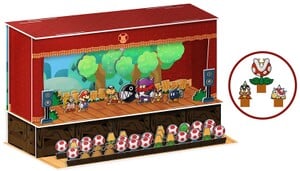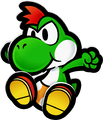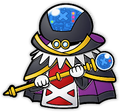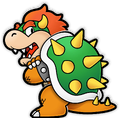Paper Mario: The Thousand-Year Door (Nintendo Switch): Difference between revisions
Crazyman14 (talk | contribs) |
Crazyman14 (talk | contribs) |
||
| Line 54: | Line 54: | ||
*The game now runs at 30 frames per second,<ref>https://www.nintendolife.com/features/hands-on-paper-mario-the-thousand-year-door-unfolds-gloriously-on-switch</ref> which is half of the 60 frames per second that the original game runs at. | *The game now runs at 30 frames per second,<ref>https://www.nintendolife.com/features/hands-on-paper-mario-the-thousand-year-door-unfolds-gloriously-on-switch</ref> which is half of the 60 frames per second that the original game runs at. | ||
*Mario's front-facing head now uses its appearance from ''[[Paper Mario: The Origami King]]'', rather than its appearance from the original game and all subsequent entries up to ''Color Splash''.<ref>https://twitter.com/NintendoAmerica/status/1775584143805391320</ref> | *Mario's front-facing head now uses its appearance from ''[[Paper Mario: The Origami King]]'', rather than its appearance from the original game and all subsequent entries up to ''Color Splash''.<ref>https://twitter.com/NintendoAmerica/status/1775584143805391320</ref> | ||
*Characters are generally more expressive | *Characters are generally more expressive. Some examples include such as more shocked expressions from participants during the kitchen mystery on the [[Excess Express]], and enemies laughing at Mario and partners when hit with ceiling debris during battles.<ref name=Direct/> | ||
*The [[Mario Bros.' House]] has a group picture of Mario's partners from the first ''[[Paper Mario]]'', as a call-forward to ''[[Super Paper Mario]]'' featuring said picture along with one for the partners from ''The Thousand-Year Door''. The map inside the house has also been changed to the world map from ''Paper Mario'', and the exterior of the bedroom was sectioned to match its design from that game.<ref name=Direct/> | *The [[Mario Bros.' House]] has a group picture of Mario's partners from the first ''[[Paper Mario]]'', as a call-forward to ''[[Super Paper Mario]]'' featuring said picture along with one for the partners from ''The Thousand-Year Door''. The map inside the house has also been changed to the world map from ''Paper Mario'', and the exterior of the bedroom was sectioned to match its design from that game.<ref name=Direct/> | ||
*When Peach's letter is being read in the opening cutscene, it is now displayed over a black background before cutting to the first view of Rogueport, where the letter itself no longer becomes visible at the bottom of the screen.<ref name=Duo/> | *When Peach's letter is being read in the opening cutscene, it is now displayed over a black background before cutting to the first view of Rogueport, where the letter itself no longer becomes visible at the bottom of the screen.<ref name=Duo/> | ||
Revision as of 15:53, April 30, 2024
This article is about an upcoming game. Editors must cite sources for all contributions to this article. Edits that do not follow this standard may be reverted without notice.
Do not upload any leaked images or media files before this game is released. Per our policy, any such files will be immediately deleted.
| Paper Mario: The Thousand-Year Door | |||||||||||||||||||
|---|---|---|---|---|---|---|---|---|---|---|---|---|---|---|---|---|---|---|---|
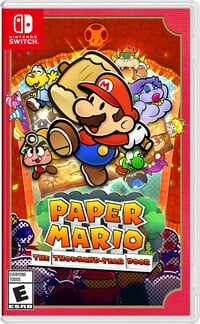 For alternate box art, see the game's gallery. | |||||||||||||||||||
| Developer | Intelligent Systems[1] | ||||||||||||||||||
| Publisher | Nintendo | ||||||||||||||||||
| Platform(s) | Nintendo Switch | ||||||||||||||||||
| Release date | Template:Release[?] | ||||||||||||||||||
| Language(s) | English (United States) French (France) French (Canada) German Spanish (Spain) Spanish (Latin America) Italian Dutch Japanese Simplified Chinese Traditional Chinese Korean | ||||||||||||||||||
| Genre | RPG | ||||||||||||||||||
| Rating(s) |
| ||||||||||||||||||
| Mode(s) | Single player | ||||||||||||||||||
Paper Mario: The Thousand-Year Door is an upcoming Nintendo Switch remake of the 2004 Nintendo GameCube game of the same name, and the first remake in the Paper Mario series. It was first announced during the September 2023 Nintendo Direct,[2] and it is set to be released worldwide on May 23, 2024.
The title will feature visually enhanced and updated graphics along with new gameplay features.[3] However, it remains faithful to the style of the original game: the characters still use their designs from the original release (notably, Princess Peach keeps her pre-Mario Party 4 dress design), rather than the updated designs used in the following Paper Mario games. A lot of voice clips from the original game are also reused, in spite of voice actor changes since the original game's release, including Charles Martinet, Jen Taylor and Scott Burns, former voice actors of Mario, Peach and Bowser respectively.
Differences
Gameplay changes
- During battles, there is an option on the bottom right corner of the screen known as "Tattle Check".[2]
- On the field,
and
have two new functions. Pressing L opens up a quick wheel selection Mario can use to switch between partners.[4] In the original,
 was only used to navigate menus.[5]
was only used to navigate menus.[5] - Like in Paper Mario: Color Splash and Paper Mario: The Origami King, a concept art gallery is available. It can be viewed from the menu, with more pieces unlocking throughout the game.[4]
- An in-game music player is now available from the menu.[4]
- A Purple Toad called the Battle Master, dressed in a tangzhuang coat and guapi mao cap can be found around the world. When talked to, he allows Mario to practice his attacks,[6] in a similar fashion to the Action Command Dojo and Battle Lab from previous games.
- A Little Mouser named Ian Foomus appears in the Trouble Center, offering advice to help with different troubles.[7]
- A new Badge known as the Nostalgic Tunes badge, depicting a Nintendo GameCube, can be bought from the Lovely Howz of Badges for 1 coin. Equipping it will revert the music to the original soundtrack.[8]
- A new warp room similar to the One World, One Pipe room in Musée Champignon from Paper Mario: The Origami King appears, replacing the original pair of warp rooms across Rogueport Sewers. When entering this room after each chapter, the Magical Map is held up similar to when taking a Crystal Star to the Thousand-Year Door, and unlocks a pipe leading to a locale for that chapter. There are seven pipe slots instead of four, and a pipe leading from this room to Rogueport plaza can also be opened.[8]
- A Save Block and Heart Block now appear at the entrance of the Pit of 100 Trials.[4]
- The minigame machines at Pianta Parlor have been changed from slot minigames to sliding minigames similar to that of the Spade Panel minigame from Super Mario Bros. 3.
- Just like Paper Mario: Color Splash onward, when hitting a Save Block the game now automatically saves instead of asking whether to save the game or not when saving.[9]
- The Mailbox SP mail system has been reworked to function similarly to the notifications system from Paper Mario: The Origami King, where alerts no longer affect the player's ability to navigate in-game.[9]
- The hot dog cutout standee next to the Hot Dog Stand in Glitzville can now be interacted with for photo ops.[8]
Text changes and localization
- The game has now been translated to Chinese (Simplified and Traditional), Dutch, Canadian French, Latin American Spanish and Korean. The original was not available in these five languages since, at the time, Nintendo of Europe did not do Dutch localizations, Nintendo of America did not do Canadian French or Latin American Spanish localizations, and Nintendo of Hong Kong and Nintendo of Korea did not yet exist.
- TEC-XX now has a red eye in all regions rather than only in Japan.[2]
- The game's logo in international regions has been redesigned to resemble the Japanese logo of the original game more. Conversely, the Japanese logo is now primarily written in English, matching the design conventions of the series's Japanese logos from Super Paper Mario onward.
- The title screen and the shot of the boat in the ocean now use a horizontal logo in international regions, similar to entries since Super Paper Mario.[8]
- By extension, the box art in international regions is now based on the Japanese box art of the original game.
- There is a "GUARD" or "SUPERGUARD" text pop-up that appears when the player successfully performs a Guard or Superguard. The original game displayed the standard "NICE" or "GREAT" text instead.
- During the Bowser intermission levels, a list of controls for Bowser is now displayed in the bottom left corner of the screen.[2]
- Text is now vertically centered within text boxes; in the original game, text was aligned to the top of the box. Also, some text has been reformatted due to the higher screen resolution allowing for more text per line.[2]
- Some English character dialogue has been altered slightly from the original game. For example, in the original, when Mario enters the town square of Rogueport for the first time, Goombella states that she is merely a "Student at the University of Goom", while in the remake, she specifically states that she is a junior at the school. In another example, the insult Bowser uses to address Kammy Koopa is changed from "Airhead" to "Lunkhead" during his interlude after completing Chapter 1.[2]
- Some other dialogue in the script also seems to have been altered. For example, the line "To find the treasure of yore, take the seven Crystal Stars to the Thousand-Year Door" was said by Goombella in the original game, but in the remake, it is said by Professor Frankly instead.
- In the Italian version, the name of the University of Goom is changed to accommodate its rename in Paper Mario: Sticker Star.[10]
- Hooktail's gender is now revealed as female much earlier, from a line from Koopie Koo: "She'll eat you up!"[11]
- Lahla now wears cat ears in the Japanese version like in all other regions, rather than bunny ears like the original in that region.[4]
- Hooktail's weakness is stated to be frogs instead of crickets, like in the original Japanese script.[7]
- The Shadow Sirens have been renamed to the "Three Shadows". When they are introduced to Mario, Beldam also states "RELATION WITHELD".[12]
Graphical changes
- The entire game has a higher-resolution, more crafted appearance similar to recent entries starting from Paper Mario: Color Splash onward, though it keeps the original game's smoother animations, rather than the choppier animations seen in those entries. For example, the characters now have a slightly thicker paper texture similar to cardstock, while the pigs have visible seams on them, and coins are fully modeled rather than sprites.[2] To go alongside these changes, dynamic lighting is now present extensively in many areas.
- The game now runs at 30 frames per second,[13] which is half of the 60 frames per second that the original game runs at.
- Mario's front-facing head now uses its appearance from Paper Mario: The Origami King, rather than its appearance from the original game and all subsequent entries up to Color Splash.[14]
- Characters are generally more expressive. Some examples include such as more shocked expressions from participants during the kitchen mystery on the Excess Express, and enemies laughing at Mario and partners when hit with ceiling debris during battles.[2]
- The Mario Bros.' House has a group picture of Mario's partners from the first Paper Mario, as a call-forward to Super Paper Mario featuring said picture along with one for the partners from The Thousand-Year Door. The map inside the house has also been changed to the world map from Paper Mario, and the exterior of the bedroom was sectioned to match its design from that game.[2]
- When Peach's letter is being read in the opening cutscene, it is now displayed over a black background before cutting to the first view of Rogueport, where the letter itself no longer becomes visible at the bottom of the screen.[8]
- The vine patterns on the ground in Boggly Woods now have an iridescent sheen than the gradient of colors used in the original game.
- The whole party is visible while riding the Cheep Blimp.[2]
- More characters can be seen from behind, such as Mario's partners, unlike in the original, where they are shown in a frontal profile regardless of the camera angle.[2]
- Due to the widescreen resolution, the HUD elements, transitions, and some interiors have been redesigned to accommodate the extra horizontal space. Framing in several cutscenes and some background scenery has also been readjusted to go alongside these changes.
- The character artwork in transitions is now shaded. The transitions themselves also go by much faster compared to the original game.
- More visual aids for points of interest have been implemented, such as a sign that displays an icon with tacked papers above the door to the Trouble Center building, and the pipe leading to Petal Meadows now resting on a grassy platform.[2]
- Areas with a dotted background, such as the backgrounds surrounding partners when they join Mario's party and the area where the black chest face resides are now fully 3D environments, rather than static backgrounds.[2]
- When a black chest face curses Mario, he gets struck by lightning, while in the original, the screen flashes white while Mario is cursed.[2]
- Pa-Patch's eyepatch now always appears over his left eye, while in the original, it would appear on the right eye if he was facing right.[2]
- Bowser now has a rainbow effect instead of flashing yellow when becoming gigantic in his levels.[2]
- The storybook intro sequence is now animated.[15]
- When drained, King K and Bandy Andy no longer have flies hovering over their bodies.
- The magenta Smorgs are not visible in the cutscene before the battle.[16]
- All of Mario's partners are now present each time he holds the Magical Map before the Thousand-Year Door.[16]
- Doopliss is now seen rocking in his chair upon his introduction at the Creepy Steeple.[4]
- The upper set of "Pianta" boards seen in the background of Paper Airplane minigame at the Pianta Parlor have been moved downwards from the logo next to the other set of boards.[4]
- The Moon is now seen when Mario and his party are launched from the cannon in Fahr Outpost.[4]
- Attacks that deal no damage now display "0" for the damage; in the original game, only a small star graphic was shown.
- Current HP numbers for Tattled enemies now have them center-aligned beneath their health bars instead of being aligned to the right.
- On the file select screen, the player now uses
to copy files and
to erase them. File 1 and 4's colors have also been swapped, with 1 being blue and 4 being yellow.[8]
- The Magical Map now starts off in a sepia tone, with each location filling in with color as its corresponding Crystal Star is located by holding it aloft before the Thousand-Year Door. New details that are added to the map also now unfold like a pop-up book.[8]
- Rogueport Sewers, Shhwonk Fortress, the Excess Express, and Riverside Station are now added to the map.
Audio changes
- The game's music has been rearranged with new instrumentation, and now sounds similar to later entries in the Paper Mario series.[2]
- Characters are given unique talking sounds during dialogue, similar to the Mario & Luigi series and the Paper Mario series from Sticker Star onward. Luigi and Princess Peach, for example, have talking sounds similar to their voices, while Koops has talking sounds identical to modern Koopa Troopa vocal effects.[2]
- When Mario stands on top of the plane panel, a sound effect reminiscent of Magic Circles from Paper Mario: The Origami King can be heard.[18]
- There is a sound effect when Mario uses Paper Mode between two walls.[18]
- The sound effect when enemies are defeated now resembles the one heard in Paper Mario: Sticker Star and Paper Mario: Color Splash.[19]
- Each level of the Rogueport Sewers now has its own music.[4]
- Similar to Paper Mario: Color Splash and Paper Mario: The Origami King, multiple variations of the main battle theme exist.[4]
- When the Boos escape the box in the Creepy Steeple, they can be heard laughing.[4]
- Bowser's theme in this game now incorporates parts of "Bowser's Castle" from Paper Mario: The Origami King.[9]
- When Parakarry delivers the Magical Map to the Mario Bros.' House, the title theme from the first game can be heard.[8]
- As Luigi reads Princess Peach's letter at the beginning of the game, an arrangement of "Inside the Castle Walls" from Super Mario 64 plays.[8]
- The battle theme begins with an arrangement of the Ground Theme motif from Super Mario Bros..
Miscellaneous
- Save files can no longer be named, much like entries from Paper Mario: Sticker Star onward.
- Only Mario is present on the title screen when the game is started for the first time; Mario's partners will each be added to the title screen when they join him.[20]
- The game's European and Japanese age ratings have been raised to PEGI 7 and CERO B, up from PEGI 3 and CERO A of the original game, respectively.
Promotion
By pre-ordering the game through the My Nintendo Store in Europe, customers would receive Mario, Goombella, and Mini-Yoshi keychains.[21] A bundle containing the game and a buildable diorama of the battle stage including several enemies and characters from the game was also made available on the store.[22]
In Australia, an A5 magnet sheet and a set of foldable Mario paper planes were included as pre-order bonuses for the game from EB Games and JB Hi-Fi, respectively.[23]
In GameStop Canada, a slip cover for the Nintendo Switch case depicting the original GameCube cover is included as a pre-order bonus.[24]
Prior to the game's release, Nintendo of Europe e-mailed a survey about the role-playing games of the Super Mario franchise to a select number of newsletter subscribers. The survey asks participants to state their opinions on topics such as the gameplay and characters of the Paper Mario series, the Mario & Luigi series, and Super Mario RPG.[25] A different survey was temporarily released by Nintendo of America via the Qualtrics website,[26] which asked participants about their general gaming experience as well as featuring questions specifically on the subject of Paper Mario: The Thousand-Year Door for Nintendo Switch.[27]
Descriptions
- North American Nintendo eShop
Join Mario on an epic paper-adventure to collect the Crystal Stars before the X-Nauts do!
The nefarious X-Nauts are after the treasure behind the Thousand-Year Door! With a map from Princess Peach, and the help of a few locals, Mario journeys through a colorful world made of paper to find them first. To prevail in this quest, you’ll have to level up Mario and his friends, master timing-based attacks and badges to impress the audience on the stage of combat, and make use of all the abilities that come with being cursed—er, conveniently made of paper—like folding into a plane to cross big gaps or turning sideways to slip through narrow openings.
Leaf through a storybook world with charming characters in every fold
Surprises abound in this deep and engaging tale, where everyone’s got something to say and it’s often not what you’d expect. Mario will meet all kinds of interesting folks on his journey, like the upbeat and studious Goombella and the shy but determined Koops. Some of these characters will need your help with their own quests, or even join your party. Others, like Peach and Bowser, have stories of their own that you’ll play between Mario’s chapters!
A classic turns the page, bringing fresh visuals and updated features
Twenty years after the original game on the Nintendo GameCube™ system, this version for the Nintendo Switch™ system has revamped graphics, and a suite of additional changes that make the game easier than ever to enjoy.
Gallery
- For this subject's image gallery, see Gallery:Paper Mario: The Thousand-Year Door (Nintendo Switch).
References to other media
- Super Mario Bros.: The battle theme begins with an arrangement of the Ground Theme motif from this game.
- Super Nintendo Entertainment System: The colors of the button icons in combat correspond to those of the Japanese and PAL controller buttons.[2]
- Super Mario 64: An arrangement of "Inside the Castle Walls" from the game plays when Luigi reads Princess Peach's letter at the beginning of the game. The Thwomp from Shwonk Fortress and Bob-omb NPCs' vocal effects are taken from the game.[17][8]
- Paper Mario: The world map from this game appears on a wall in the Mario Bros.' House. An arranged version of this game's title screen theme play when Parakarry delivers the Magical Map to the Mario Bros.' House.[2]
- Nintendo GameCube: The Nostalgic Tunes badge resembles the titular console, and its description mentions the console itself.[8]
- Super Paper Mario: The Mario Bros.' House now has the same picture of Mario's partners from Paper Mario as seen in this game.[2]
- Paper Mario: The Origami King: Bowser's leitmotif from this game has been incorporated into his rearranged theme in this game.[9]
Names in other languages
| Language | Name | Meaning | Notes |
|---|---|---|---|
| Japanese | ペーパーマリオRPG[?] Pēpā Mario Āru Pī Jī |
Paper Mario RPG This naming method is similar to Super Mario RPG and the Japanese name of Mario & Luigi: Superstar Saga. |
|
| Chinese (simplified) | 纸片马力欧RPG[?] Zhǐpiàn Mǎlì'ōu RPG |
Paper Mario RPG | |
| Chinese (traditional) | 紙片瑪利歐RPG[28] Zhǐpiàn Mǎlì'ōu RPG |
Paper Mario RPG | |
| Dutch | Paper Mario: The Thousand-Year Door[?] | - | |
| French (NOA) | Paper Mario: The Thousand-Year Door[?] | - | |
| French (NOE) | Paper Mario: La Porte Millénaire[?] | Paper Mario: The Millennium Door | |
| German | Paper Mario: Die Legende vom Äonentor[?] | Paper Mario: The Legend of the Aeon Gate | |
| Italian | Paper Mario: Il Portale Millenario[?] | Paper Mario: The Millennium Portal | |
| Korean | 페이퍼 마리오 1000년의 문[?] Peipeo Malio Cheon-nyeon-ui Mun |
Paper Mario: The Thousand-Year Door | |
| Portuguese | Paper Mario: The Thousand-Year Door[?] | - | |
| Spanish (NOA) | Paper Mario: The Thousand-Year Door[?] | - | |
| Spanish (NOE) | Paper Mario: La Puerta Milenaria[?] | Paper Mario: The Millennium Door |
Trivia
- This is the second Super Mario game after Super Mario Odyssey to receive a B rating by the CERO in Japan.
External links
- Official North American game page
- Official Japanese game page
- Official Canadian (French) game page
- Official Latin American game page
- Official Brazilian game page
- Official United Kingdom game page
- Official Belgium (Dutch) game page
- Official Belgium (French) game page
- Official German game page
- Official España game page
- Official French game page
- Official Italian game page
- Official Dutch game page
- Official Austrian game page
- Official Portuguese game page
- Official Swiss (German) game page
- Official Swiss (French) game page
- Official Swiss (Italian) game page
- Official South African game page
- Official Australian game page
- Official Singaporean game page
- Official Malaysian game page
- Official Filipino game page
- Official Thai game page
- Official Korean game page
- Official Taiwanese game page
- Official Hong Kong game page
References
- ^ Nintendo UK Store page Screenshot
- ^ a b c d e f g h i j k l m n o p q r s t u Nintendo of America (September 14, 2023). Nintendo Direct 9.14.2023 - Nintendo Switch. YouTube. Retrieved September 14, 2023.
- ^ "The witty and whimsical RPG arrives on the Nintendo Switch system twenty years after its original debut on Nintendo GameCube. This revamped version features enhanced graphics as well as new gameplay features." Nintendo celebrates Mar10 Day with games, movie news and a variety of Mario-themed activities. Nintendo.com. Retrieved March 11, 2024.
- ^ a b c d e f g h i j k https://www.youtube.com/watch?v=cCWhnJYWdkU
- ^ https://www.reddit.com/r/papermario/comments/1c3180t/new_ttyd_gameplay_screenshots/
- ^ https://www.nintendo.com/jp/topics/article/a37c0bd2-647f-4547-9d74-a2ec35d46faf
- ^ a b Good Vibes Gaming (April 24, 2024). Paper Mario: TTYD Is So Much Better on Switch. YouTube. Retrieved April 26, 2024.
- ^ a b c d e f g h i j k l Nintenduo World (April 25, 2024). 15 Minutes of PAPER MARIO The Thousand-Year Door REMAKE - Exclusive NEW GAMEPLAY 🍄 (Nintendo Switch). YouTube. Retrieved April 25, 2024.
- ^ a b c d CGMagazine (April 25, 2024). First Fifteen: Paper Mario: The Thousand-Year Door. YouTube. Retrieved April 25, 2024.
- ^ Paper Mario: Il Portale Millenario arriva su Nintendo Switch nel 2024!; NintendoItalia on YouTube. Retrieved on September 14, 2023
- ^ 20 Minutes of NEW Paper Mario The Thousand Year Door Switch Remake Footage
- ^ Mirror Gaming (April 25, 2024). Revitalised Cult Classic - Paper Mario: The Thousand Year Door Preview. YouTube. Retrieved April 25, 2024.
- ^ https://www.nintendolife.com/features/hands-on-paper-mario-the-thousand-year-door-unfolds-gloriously-on-switch
- ^ https://twitter.com/NintendoAmerica/status/1775584143805391320
- ^ https://youtube.com/watch?v=6JOv3gxmwbA&si=spuFm1-oWuLQN36_
- ^ a b @NintendoUK (April 18, 2024). "A scary dragon atop a tall tower? A cursed town full of…pigs? A train ride packed with high-speed hijinx? All this and more awaits you in #PaperMario: The Thousand-Year Door!" X. Retrieved April 24, 2024.
- ^ a b VGC (April 24, 2024). Paper Mario: Thousand Year Door Switch exclusive gameplay. YouTube. Retrieved April 26, 2024.
- ^ a b https://topics.nintendo.co.jp/article/aa63dd30-4bb8-4f17-83b9-a39e1d985fde
- ^ https://youtu.be/re-3JIatUTw
- ^ https://www.reddit.com/r/papermario/comments/1cctdt9/it_seems_like_partnerscharacters_will_appear_in/
- ^ https://store.nintendo.co.uk/en/paper-mario-the-thousand-year-door-70010000073127
- ^ https://store.nintendo.co.uk/en/paper-mario-the-thousand-year-door-buildable-battle-stage-B00576
- ^ Vuckovic, D. (March 13, 2024). Aussie Bargain Roundup: Paper Mario: The Thousand-Year Door. Vooks. Retrieved March 20, 2024.
- ^ @NinWire (April 24, 2024). "GameStop in Canada has an awesome GameCube Slipcover pre-order bonus for Paper Mario: The Thousand Year Door. No word on a US bonus yet! Stay tuned!" X. Retrieved April 26, 2024.
- ^ I just got a survey in my e-mail asking me about my opinions on the different Mario RPGs. Here are some of the questions that were included.. Reddit (via r/Mario). Retrieved April 19, 2024. (Archived April 3, 2024, 08:10:30 UTC via Wayback Machine.)
- ^ Link to the survey. nintendo.com. (Archived April 18, 2024, 23:47:08 UTC via Wayback Machine.)
The above link redirects users to the following page:
nintendoofamerica.co1.qualtrics.com. Retrieved April 19, 2024. (Archived April 17, 2024, 14:59:37 UTC via Wayback Machine.) - ^ Reecee (April 17, 2024). Nintendo's Paper Mario TTYD Survey is Publicly Available, Fill It Out!. YouTube. Retrieved April 19, 2024.
- ^ (September 14, 2023). 《紙片瑪利歐RPG》的最新資訊公開!本作預定於2024年發售。 Nintendo HK. Retrieved September 14, 2023.
